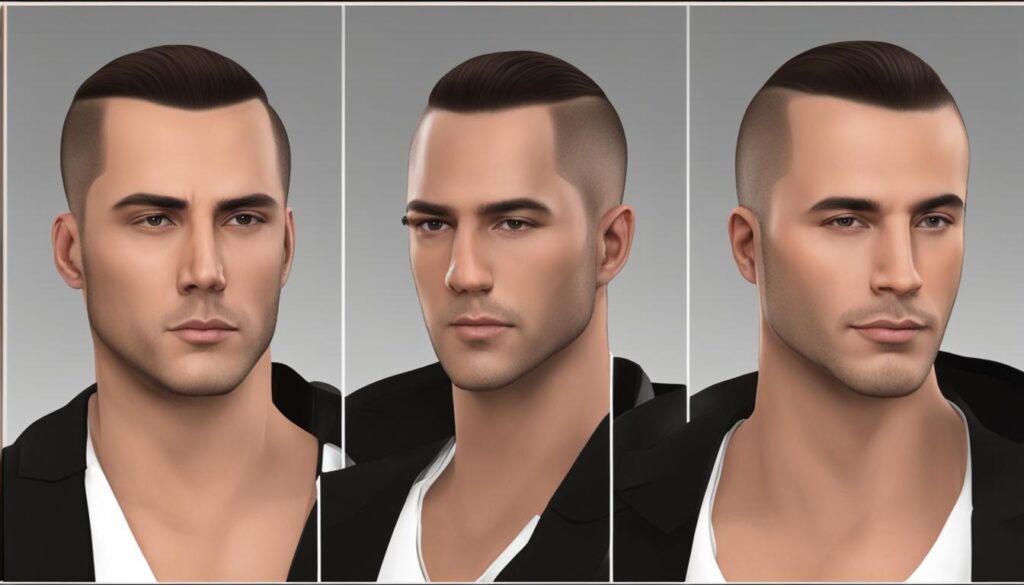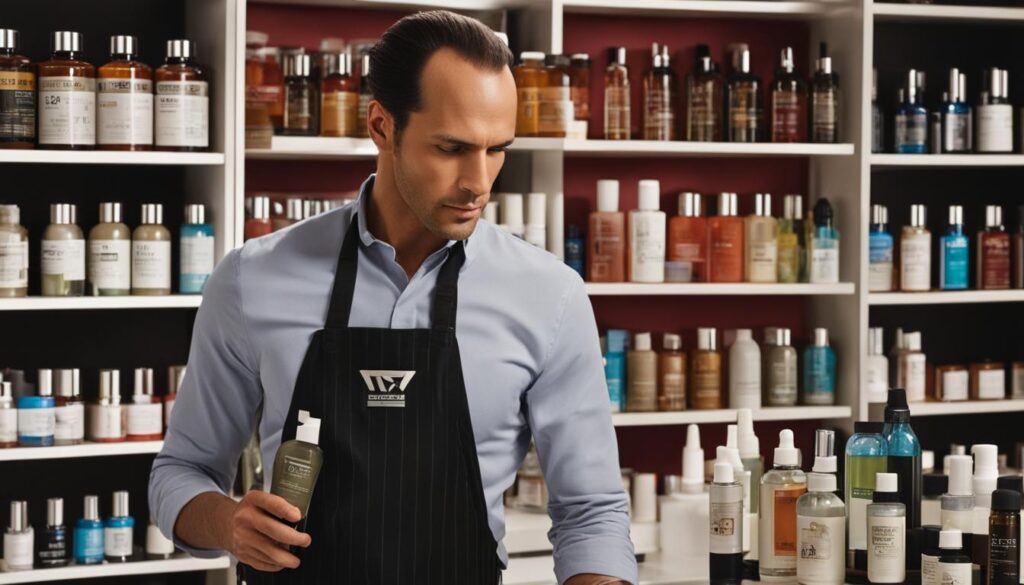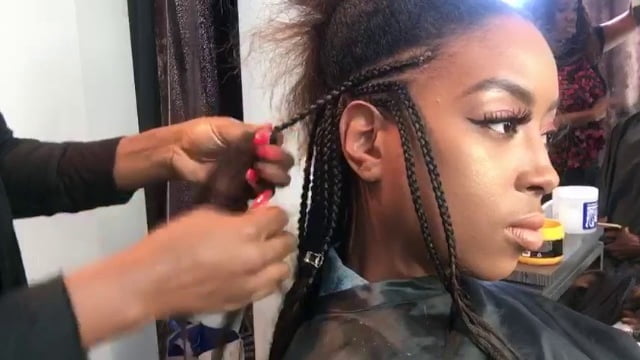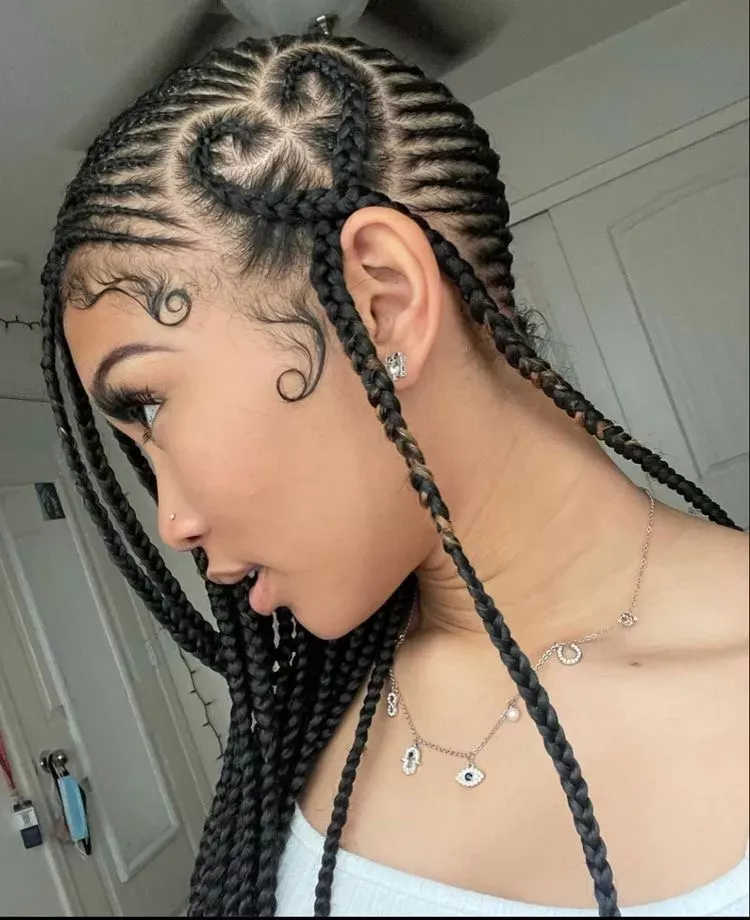How can I regrow my frontal hairline?
A receding hairline, also known as androgenetic alopecia, is a common condition that affects both males and females. It typically begins above the temples in males, creating a distinct “M” shape, and can progress to the top and back of the head, leaving a horseshoe-like pattern of baldness. Females may experience diffuse hair thinning in the middle of the head. While there is no outright cure for a receding hairline, there are medications, such as finasteride and minoxidil, that may slow down the progression and encourage hair regrowth. Other treatments like hair transplants or laser surgery may also be options. Additionally, lifestyle choices, such as reducing stress, exercising regularly, and maintaining a healthy diet, can help manage a receding hairline.
Key Takeaways:
- There is no definitive cure for a receding hairline, but medications like finasteride and minoxidil may slow down the progression and encourage regrowth.
- Other treatment options for regrowing the frontal hairline include hair transplants and laser surgery.
- Lifestyle choices, such as reducing stress, exercising regularly, and maintaining a healthy diet, can contribute to managing a receding hairline.
- Natural remedies like peppermint and lavender oils may promote hair growth, but more research is needed to confirm their effectiveness.
- Adopting a healthy hair care routine and experimenting with different hairstyles can help manage the appearance of a receding hairline.
Causes of a Receding Hairline
Understanding the causes of a receding hairline can help shed light on why this common condition occurs. While there is no single factor that can be solely blamed for a receding hairline, several key factors can contribute to its development.
Age and hair loss: As we age, the natural process of hair growth slows down, and the hair follicles become less active. This can lead to thinning and receding of the hairline.
Hormonal changes and hair loss: Hormonal imbalances, particularly an increase in androgen hormones like DHT (dihydrotestosterone), can contribute to hair loss, including a receding hairline. These hormonal changes can be influenced by genetics, lifestyle choices, or underlying medical conditions.
Family history and hair loss: A family history of hair loss can indicate a genetic predisposition to a receding hairline. If your parents or grandparents experienced hair loss, there is a higher likelihood that you may also experience it.
Medications and hair loss: Certain medications, such as those used for cancer treatment (chemotherapy) or autoimmune diseases, can cause hair loss as a side effect. It’s important to discuss potential hair loss side effects with your healthcare provider before starting any new medications.
Illness and hair loss: Some acute or chronic illnesses, including thyroid disorders or scalp infections, can lead to temporary or permanent hair loss, including a receding hairline.
Lifestyle choices and hair loss: Certain lifestyle choices, such as smoking, excessive alcohol consumption, a poor diet lacking essential nutrients, or high-stress levels, can contribute to hair loss and a receding hairline.
Recognizing these potential causes of a receding hairline can help individuals take proactive steps to manage and potentially slow down hair loss. However, it’s important to note that consulting with a healthcare professional is crucial to accurately diagnose the underlying cause and determine the most effective treatment options for each individual.
Medications and Treatments for Regrowing Frontal Hairline
When it comes to regrowing a receding hairline, there are several medications and treatments that may help slow down the progression and encourage hair growth. Two FDA-approved medications commonly used for hair loss are finasteride and minoxidil.
Finasteride: Also known as Propecia, finasteride works by blocking the conversion of testosterone to dihydrotestosterone (DHT), a hormone that can contribute to hair loss. It is available in pill form and is typically taken once daily.
Minoxidil: Marketed as Rogaine, minoxidil is a topical solution that can be applied directly to the scalp. It works by prolonging the growth phase of the hair follicles and increasing blood flow to the scalp, promoting hair regrowth. Minoxidil is available over-the-counter in various strengths.
It’s important to note that individual results may vary, and it may take several months of consistent use before any noticeable improvements are seen.
In some cases, off-label medications may be prescribed for hair loss. These medications, such as spironolactone or ketoconazole, are typically used for other conditions but have shown potential in treating hair loss when used topically or orally. It’s important to consult with a healthcare professional to determine the most suitable treatment option.
For individuals seeking more permanent solutions, hair transplants and laser surgery are options to consider. Hair transplants involve transplanting hair follicles from the back or sides of the head to the frontal hairline, creating a more natural-looking hairline. Laser surgery, on the other hand, uses low-level laser therapy to stimulate hair growth. These procedures should be performed by qualified professionals and require careful consideration and discussion with a healthcare provider.

Natural Remedies for Regrowing Frontal Hairline
While there are medications and treatments available for regrowing a receding hairline, some individuals may prefer to explore natural remedies as an alternative. While more research is needed to confirm their effectiveness, there are a few natural options that have shown promise.
Peppermint Oil for Hair Growth
One natural remedy that has gained attention for its potential to promote hair growth is peppermint oil. Animal studies have suggested that peppermint oil may stimulate the hair follicles, resulting in increased hair growth. To use peppermint oil, you can mix a few drops with a carrier oil, such as coconut oil, and massage it into your scalp. It’s important to note that individual results may vary, and it’s always best to consult with a healthcare professional before trying any natural remedies.
Lavender Oil for Hair Growth
Another natural remedy that may promote hair growth is lavender oil. Like peppermint oil, lavender oil has been studied in animal models and has shown some potential benefits. To use lavender oil, you can mix a few drops with a carrier oil and massage it into your scalp. Again, it’s important to remember that individual results may vary, and it’s best to consult with a healthcare professional before incorporating any natural remedies into your hair care routine.
While natural remedies like peppermint oil and lavender oil may offer some potential benefits, it’s important to remember that there is no guaranteed solution for regrowing a receding hairline. It’s always best to consult with a healthcare professional to determine the most suitable treatment option for your individual circumstances and needs.
Summary:
- Peppermint oil may stimulate hair growth and can be mixed with a carrier oil for topical application.
- Lavender oil has shown potential benefits for promoting hair growth and can also be mixed with a carrier oil for scalp massage.
- Consult with a healthcare professional before trying any natural remedies to ensure they are suitable for your specific situation.
Hair care and styling tips for managing a receding hairline
While there may be no cure for a receding hairline, there are several hair care and styling tips that can help manage its appearance. By experimenting with different hairstyles and adopting a healthy hair care routine, individuals can enhance their overall hair health and draw attention away from the receding hairline.
Hairstyles for Receding Hairline:
- Slicked-back undercut: This style involves keeping the hair on the sides and back shorter while combing back the remaining hair on top to create a sleek, polished look.
- Close buzz cut: A close buzz cut can minimize the contrast between the receding hairline and the rest of the hair, creating a more uniform appearance.
- Medium crew cut: This style keeps the hair slightly longer on top while trimming the sides and back. It provides a balanced and stylish look.
- Clean shave: For individuals comfortable with a bold look, a clean shave can eliminate the appearance of a receding hairline altogether.
By adopting a healthy hair care routine, individuals can support their hair’s overall health and minimize the effects of a receding hairline. This includes using gentle shampoo and conditioner, moisturizing the hair regularly, and avoiding harsh chemicals or styling products that can lead to further damage.
Reducing stress can also have a positive impact on hair health, including managing a receding hairline. Engaging in stress-relieving activities, practicing relaxation techniques, and maintaining a balanced lifestyle can help promote hair regrowth and reduce the progression of hair loss.
Remember, it’s essential to consult with a healthcare professional or a stylist to determine the best approach for managing a receding hairline based on individual circumstances and needs.

Additional tips for managing a receding hairline
When it comes to managing a receding hairline, there are a few additional tips that can help support hair health and potentially slow down the progression. One important factor to consider is reducing stress, as high stress levels have been linked to hair loss. Finding ways to effectively manage stress, such as practicing relaxation techniques like meditation or yoga, engaging in regular exercise, or pursuing hobbies and activities that bring joy and relaxation, can have a positive impact on both mental well-being and hair regrowth.
In addition to stress reduction, maintaining a healthy overall lifestyle is crucial for managing a receding hairline. A balanced diet that includes plenty of fruits, vegetables, lean proteins, and essential nutrients like vitamins A, C, and E, as well as minerals like zinc and iron, can help promote healthy hair growth. It’s also important to stay hydrated and limit the consumption of processed foods, sugary snacks, and beverages.
Furthermore, avoiding harmful habits like smoking and excessive alcohol consumption can contribute to better hair health. Smoking has been linked to hair loss and premature graying, while excessive alcohol intake can lead to nutrient deficiencies and dehydration, both of which can negatively impact hair growth. By prioritizing a healthy lifestyle and making mindful choices, individuals with a receding hairline can take proactive steps towards supporting their hair regrowth journey.
Summary:
- Reducing stress through relaxation techniques and regular exercise can help manage a receding hairline.
- Maintaining a balanced diet rich in vitamins and minerals is essential for promoting hair regrowth.
- Avoiding harmful habits like smoking and excessive alcohol consumption can support overall hair health.

“Finding ways to effectively manage stress, such as practicing relaxation techniques like meditation or yoga, engaging in regular exercise, or pursuing hobbies and activities that bring joy and relaxation, can have a positive impact on both mental well-being and hair regrowth.”
Conclusion
A receding hairline can be a common concern for both men and women, but there are various treatment options and strategies available to manage and potentially slow down its progression. While there is no definitive cure for regrowing the frontal hairline, medications like finasteride and minoxidil, along with natural remedies like peppermint and lavender oils, may offer some potential benefits.
Managing stress and maintaining a healthy lifestyle
In addition to medical treatments, adopting a healthy hair care routine and experimenting with different hairstyles can contribute to overall hair health. It’s important to consult with a healthcare professional to determine the best approach for your individual circumstances and needs.
Reducing stress levels through relaxation techniques and engaging in stress-relieving activities can have a positive impact on hair health. In addition, maintaining a healthy lifestyle that includes regular exercise, a balanced diet rich in vitamins and minerals, and avoiding smoking or excessive alcohol consumption can further support the health of your hair and scalp.
Consulting with a healthcare professional
It’s worth noting that regrowing a frontal hairline requires a personalized approach, and the effectiveness of different treatments may vary from person to person. Consulting with a healthcare professional specializing in hair health can provide you with the guidance and support needed to make informed decisions about your hair regrowth journey. They can help assess your specific situation, recommend appropriate treatments, and monitor your progress over time.
FAQ
How can I regrow my frontal hairline?
While there is no outright cure for a receding hairline, there are medications like finasteride and minoxidil that may slow down the progression and encourage hair regrowth. Other options include hair transplants and laser surgery. It’s important to consult with a healthcare professional to determine the most suitable treatment option for you.
What are the causes of a receding hairline?
A receding hairline can be caused by various factors including age, hormonal changes, family history, certain medications or medical treatments, illness or stress, and lifestyle choices. However, it’s important to note that these factors may contribute to a receding hairline but do not guarantee it will occur.
What medications and treatments are available for regrowing the frontal hairline?
Medications like finasteride (Propecia) and minoxidil (Rogaine) are FDA-approved for the treatment of hair loss and may help slow down the progression and encourage hair regrowth. Hair transplants and laser surgery are also options for individuals seeking more permanent solutions. Consult with a healthcare professional to determine the most suitable treatment option for you.
Are there any natural remedies for regrowing the frontal hairline?
While more research is needed to confirm their effectiveness, animal studies suggest that peppermint and lavender oils may promote hair growth. These oils can be applied topically to the scalp, but individual results may vary. It’s always best to consult with a healthcare professional before trying any natural remedies.
What are some hair care and styling tips for managing a receding hairline?
Experimenting with different hairstyles like a slicked-back undercut, close buzz cut, medium crew cut, or clean shave can help draw attention away from a receding hairline. Adopting a healthy hair care routine, using gentle products, moisturizing the hair, and avoiding harsh chemicals can also support overall hair health. Additionally, reducing stress through regular exercise, breathing exercises, and maintaining a balanced diet can contribute to better hair and scalp health.
Are there any additional tips for managing a receding hairline?
Finding ways to reduce stress, such as practicing relaxation techniques or engaging in stress-relieving activities, can have a positive impact on hair health. It’s also important to maintain a healthy lifestyle overall, which includes getting enough exercise, eating a balanced diet rich in vitamins and minerals, and avoiding smoking or excessive alcohol consumption.







